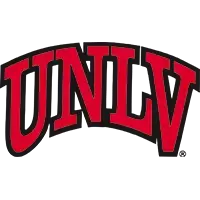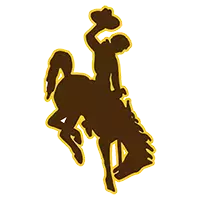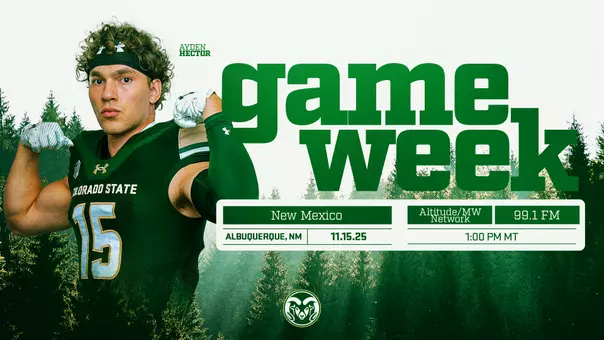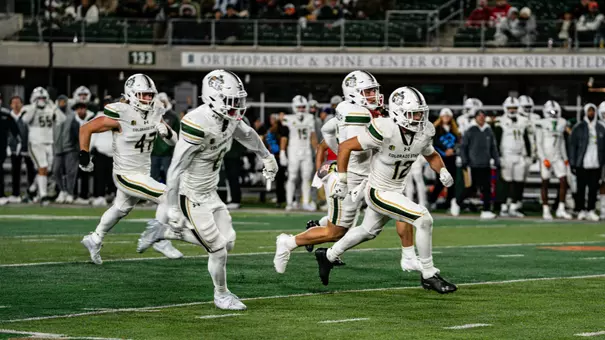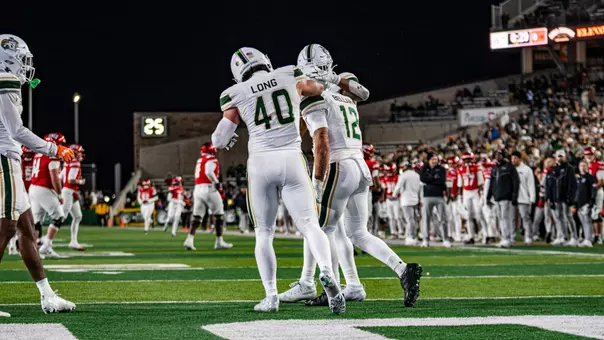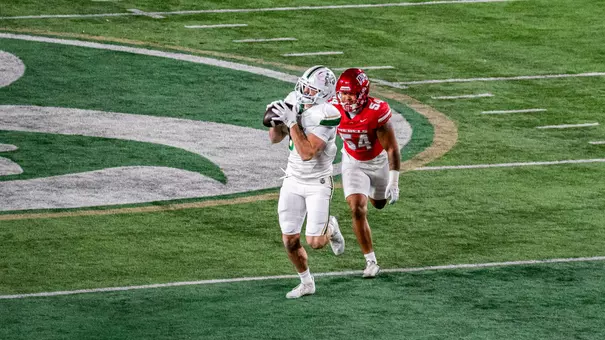Colorado State University Athletics
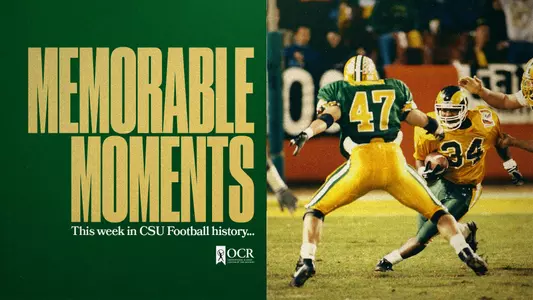
Memorable Moments: The 1990 Rams Transformed CSU Football
10/16/2025 2:00:00 PM | Football
Freedom Bowl win set a new path for program
Homecoming week is a time to look back on college days long past and reflect on good times at Colorado State. The 2025 season marks 35 years since the 1990 Rams football team transformed CSU football from nightmarish days to its greatest period in the school's football history. On a national scale, in 1988, CSU was at the bottom of all Division I schools, and within 10 years of the 1990 football team's success, CSU was recognized across the nation as a powerful team.
Looking back on the 1990 season, you must look further back at the previous 35 years of Rams football to understand why coach Earle Bruce's team was the key to transforming CSU's football program.
In 1955, coach Bob Davis won the Skyline Conference championship after a 21-year drought of championships for Aggies football. However, Davis stepped down in 1956 and over the course of the next 34 years the program only saw eight winning seasons and no championships. The closest a Rams team came to a conference championship was in 1977 and 1980 when they narrowly missed a WAC championship, getting edged out by BYU in both seasons. (The collapse of the 1986 season is another story for another day.)
From 1955 to 1989, CSU football had a .368 winning percentage, was kicked out of its conference due to poor facilities and while there may have been some encouraging years in 1966, 1977 and 1986, none of those teams propelled the program to the next level in its following years. In 1986, freshman John Laurita joined the team and was on the field to see the Rams beat CU in Boulder and make a WAC championship run, but that all changed after the veterans graduated and CSU's football success dropped immensely.
Laurita looked back on his time at CSU from his home in Nevada and said, "Heading into the 1987 season, expectations were low. We had a largely inexperienced roster, and the opener against Tennessee in Knoxville marked the beginning of a tough 1–11 season. We were young and unfamiliar with the intensity of southern football. The season quickly unraveled, players rotated through positions, and team unity was lacking. Many upperclassmen had mentally checked out midway through the season. However, a small core group of us who had come to CSU together began gaining valuable playing time and experience. We were committed, united, and driven by the belief that one day we'd lead the team as upperclassmen."
Laurita, an offensive guard, went on to say, "In 1988, still underclassmen, we finished 1–10. Doubts crept in, about ourselves, the coaching staff, and the program. But we continued to grow, and new talent joined the team. At season's end, the coaching staff was replaced, and we were all curious about what would come next. When Earle Bruce was announced as our new head coach, excitement surged. His reputation preceded him, and we knew change was coming."
Bruce instilled a tough attitude in his players, challenging them at every level. His first season in 1989 produced a 5-5-1 record, the second-best turnaround in the nation and confidence in the players. Bruce also brought with him the ability to recruit players from all over the country, partially due to his successes at Iowa State and Ohio State. When he was hired, Bruce was asked what kind of assistant coaches he wanted, his reply was that he sought honest, hard working coaches with varied background in the game who communicate with players.
That saw coaches like Skip Holtz, son of Notre Dame legend Lou Holtz, Tom Ehlers, a CSU grad with great coaching instincts, Chuck Heater as defensive coordinator and in 1990, a young wide receivers coach named Urban Meyer. Laurita looked back and said, "By 1990, Coach Bruce had instilled belief in the team, the program, and ourselves. He asked us to set goals before the season. While some suggested a winning record, others aimed higher: going undefeated at home and earning a bowl game invitation. Coach Bruce was surprised but impressed. Back then, with only 19 bowl games, it was a lofty goal, especially for CSU."
The Rams did win all six of their home games in 1990, and after a close win in Hawaii to close out the season, were invited to the Freedom Bowl, the first official bowl invitation since 1955 and first one played since 1949. The Rams shocked Oregon with a one-point victory in a thrilling game and Rams fans and players ended 1990 on a high note following the school's first bowl win.
This is when the fortunes of CSU football began to rise in a manner never seen since the start of WWI. In 1991, CSU played BYU on a Halloween night at Hughes Stadium for the first nationally televised game in Fort Colins. ESPN trucked in temporary lights and students wore Bruce Halloween masks. While that game was a loss, it started a 34-year run of CSU football on any ESPN network, since then the Rams have played 90 games on the national sports network, including bowl games. From 1956 to 1989, CSU had only been seen on national television three times.
Television played a key role in the Rams rise. From 1956 to 1989 the Rams were only seen on local or regional television 30 times. Since then, they have appeared on TV 351 times, but some of that is attributed to the expansion of television in sports altogether.
Another major turning point came in 1992 and 1993, when Bruce was fired, and Sonny Lubick was brought on as CSU's 18th coach in program history. Lubick built upon Bruce's talent for recruiting; the team was filled with talented players brought to CSU by Bruce and Lubick made the most of it in 1994 by winning the school's first WAC championship and first conference title in 39 years. You could then say, "The rest is history" but there is more CSU's success.
When looking at the record, CSU football has seen a .500 winning percentage since 1990, played in 17 bowl games and produced four consensus or unanimous All-Americans while prior to 1990 CSU saw no bowl games, the previously mentioned .368 winning percentage and only one consensus All-American.
The national recognition and television appearances have also made an impact. Former CSU tight end and Hall of Famer Keli McGregor, who played in the tough times of the early 1980s said in a 2008 interview that while in New York City on business with the Colorado Rockies a cab driver asked him where he was from. McGregor told him Colorado, and the driver said, "I like the Rams, I am watching them tonight on TV." McGregor was dumbfounded that a New York cab driver knew about CSU football, something he knew would never have happened in the 1980s.
Success, national exposure and players who went on to NFL careers helped bring CSU football into the spotlight. A new stadium in 2017 and moving up to the PAC 12 in 2026, has taken CSU football well above where it was 35 years ago. Looking back at 1990, we can easily see this was the year that transformed Rams football from not even loveable losers to national acclaim.
What will the next 35 years of football bring as the Rams enter a new phase of their program?
Looking back on the 1990 season, you must look further back at the previous 35 years of Rams football to understand why coach Earle Bruce's team was the key to transforming CSU's football program.
In 1955, coach Bob Davis won the Skyline Conference championship after a 21-year drought of championships for Aggies football. However, Davis stepped down in 1956 and over the course of the next 34 years the program only saw eight winning seasons and no championships. The closest a Rams team came to a conference championship was in 1977 and 1980 when they narrowly missed a WAC championship, getting edged out by BYU in both seasons. (The collapse of the 1986 season is another story for another day.)
From 1955 to 1989, CSU football had a .368 winning percentage, was kicked out of its conference due to poor facilities and while there may have been some encouraging years in 1966, 1977 and 1986, none of those teams propelled the program to the next level in its following years. In 1986, freshman John Laurita joined the team and was on the field to see the Rams beat CU in Boulder and make a WAC championship run, but that all changed after the veterans graduated and CSU's football success dropped immensely.
Laurita looked back on his time at CSU from his home in Nevada and said, "Heading into the 1987 season, expectations were low. We had a largely inexperienced roster, and the opener against Tennessee in Knoxville marked the beginning of a tough 1–11 season. We were young and unfamiliar with the intensity of southern football. The season quickly unraveled, players rotated through positions, and team unity was lacking. Many upperclassmen had mentally checked out midway through the season. However, a small core group of us who had come to CSU together began gaining valuable playing time and experience. We were committed, united, and driven by the belief that one day we'd lead the team as upperclassmen."
Laurita, an offensive guard, went on to say, "In 1988, still underclassmen, we finished 1–10. Doubts crept in, about ourselves, the coaching staff, and the program. But we continued to grow, and new talent joined the team. At season's end, the coaching staff was replaced, and we were all curious about what would come next. When Earle Bruce was announced as our new head coach, excitement surged. His reputation preceded him, and we knew change was coming."
Bruce instilled a tough attitude in his players, challenging them at every level. His first season in 1989 produced a 5-5-1 record, the second-best turnaround in the nation and confidence in the players. Bruce also brought with him the ability to recruit players from all over the country, partially due to his successes at Iowa State and Ohio State. When he was hired, Bruce was asked what kind of assistant coaches he wanted, his reply was that he sought honest, hard working coaches with varied background in the game who communicate with players.
That saw coaches like Skip Holtz, son of Notre Dame legend Lou Holtz, Tom Ehlers, a CSU grad with great coaching instincts, Chuck Heater as defensive coordinator and in 1990, a young wide receivers coach named Urban Meyer. Laurita looked back and said, "By 1990, Coach Bruce had instilled belief in the team, the program, and ourselves. He asked us to set goals before the season. While some suggested a winning record, others aimed higher: going undefeated at home and earning a bowl game invitation. Coach Bruce was surprised but impressed. Back then, with only 19 bowl games, it was a lofty goal, especially for CSU."
The Rams did win all six of their home games in 1990, and after a close win in Hawaii to close out the season, were invited to the Freedom Bowl, the first official bowl invitation since 1955 and first one played since 1949. The Rams shocked Oregon with a one-point victory in a thrilling game and Rams fans and players ended 1990 on a high note following the school's first bowl win.
This is when the fortunes of CSU football began to rise in a manner never seen since the start of WWI. In 1991, CSU played BYU on a Halloween night at Hughes Stadium for the first nationally televised game in Fort Colins. ESPN trucked in temporary lights and students wore Bruce Halloween masks. While that game was a loss, it started a 34-year run of CSU football on any ESPN network, since then the Rams have played 90 games on the national sports network, including bowl games. From 1956 to 1989, CSU had only been seen on national television three times.
Television played a key role in the Rams rise. From 1956 to 1989 the Rams were only seen on local or regional television 30 times. Since then, they have appeared on TV 351 times, but some of that is attributed to the expansion of television in sports altogether.
Another major turning point came in 1992 and 1993, when Bruce was fired, and Sonny Lubick was brought on as CSU's 18th coach in program history. Lubick built upon Bruce's talent for recruiting; the team was filled with talented players brought to CSU by Bruce and Lubick made the most of it in 1994 by winning the school's first WAC championship and first conference title in 39 years. You could then say, "The rest is history" but there is more CSU's success.
When looking at the record, CSU football has seen a .500 winning percentage since 1990, played in 17 bowl games and produced four consensus or unanimous All-Americans while prior to 1990 CSU saw no bowl games, the previously mentioned .368 winning percentage and only one consensus All-American.
The national recognition and television appearances have also made an impact. Former CSU tight end and Hall of Famer Keli McGregor, who played in the tough times of the early 1980s said in a 2008 interview that while in New York City on business with the Colorado Rockies a cab driver asked him where he was from. McGregor told him Colorado, and the driver said, "I like the Rams, I am watching them tonight on TV." McGregor was dumbfounded that a New York cab driver knew about CSU football, something he knew would never have happened in the 1980s.
Success, national exposure and players who went on to NFL careers helped bring CSU football into the spotlight. A new stadium in 2017 and moving up to the PAC 12 in 2026, has taken CSU football well above where it was 35 years ago. Looking back at 1990, we can easily see this was the year that transformed Rams football from not even loveable losers to national acclaim.
What will the next 35 years of football bring as the Rams enter a new phase of their program?
Colorado State Football: Tyson Summers Weekly Press Conference - Week 10 (2025)
Monday, November 10
Colorado State Football: Dupree (L) and Bellah (R) Postgame (UNLV, 2025)
Saturday, November 08
Colorado State Football: Tyson Summers Post-Game (UNLV, 2025)
Saturday, November 08
Colorado State Football: Tyson Summers Weekly Press Conference - Week 9 (2025)
Monday, November 03





